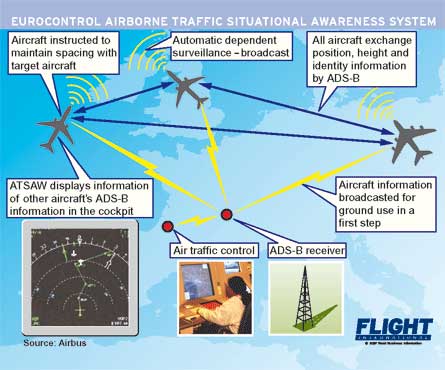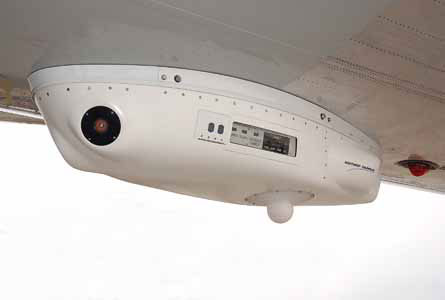Last week's first revenue flight of a FedEx Express Boeing MD-10 freighter carrying a Northrop Grumman laser anti-missile system spotlights progress with counter-terrorism technologies aimed at making commercial airliners more difficult to commandeer or shoot down.
Areas of active research and development in the USA and Europe include defeating man-portable air-defence systems (Manpads) hardening cargo containers and aircraft structures against explosions providing more-secure identification of passengers and crews and finding ways to take control away from the cockpit if an aircraft strays from its planned track.
In the USA, the bulk of counter-terror work is being done under the umbrella of the Department of Homeland Security (DHS) and, to a lesser extent, the Federal Aviation Administration. Several aerospace companies are also developing concepts or systems on their own.

Across the Atlantic, technologies are being pursued under the Security of Aircraft in the Future European Environment (SAFEE) programme - a four-year, €37 million ($48 million) effort that began in 2004, funded 50:50 by the European Commission and industry. Under the programme, Airbus, BAE Systems, Sagem, Thales and Dutch national aerospace laboratory NLR are overseeing key initiatives with the help of 26 additional companies. Focus areas include on-board threat detection systems, threat assessment and response management, and automatic guidance systems to safely secure an aircraft under siege.
Thales Avionics this year plans to begin testing a ground simulation of an anti-hijack system that monitors the aircraft's flight based on pre-planned waypoints in an on-board database. Sagem Défense Sécurité's Daniel Gaultier, co-ordinator of the SAFEE programme, says the idea is to prevent the aircraft from entering sensitive areas, special events or target areas like nuclear powerplants. "We are developing this type of authentication to make terrorists know it will be very difficult to take control [of the aircraft]," he says.
If the system senses an "uncontrolled behaviour or trajectory", the software will first ask the pilot and co-pilot to authenticate their presence in the cockpit to verify the aircraft has a minimum crew. If the query produces an unsatisfactory result, the system will then take control of the aircraft for an undetermined duration, not to include landing. "We have not developed this as far as the landing process," says Gaultier. "The main problem is pilots accepting the complete landing by the system."
Threat detection
Ideally, terrorists would not have made it into the cockpit through the SAFEE safety net. Airbus has designed a threat detection system that uses video cameras and microphones in the cabin to alert pilots to suspicious or strange passenger behaviour. The company is planning to simulate the system early next year. NLR this year will test a cockpit-door biometric entry pad that uses fingerprint identification technology developed by Sagem, rather than a traditional keypad, to control access to the cockpit.
In the USA, the DHS's main priority is the Counter-Manpads programme, launched by Congress in 2003 and now in its third phase of development. Other work includes aircraft and cargo hardening efforts and Propulsion Control for Aircraft Recovery (PCAR). The FAA, which transferred most of its security functions to the DHS after its creation in 2002 and completed its cockpit door fortification programme in 2003, is also advocating more robust structures. The agency has proposed a rule requiring manufacturers to strengthen future aircraft structures to better withstand an in-flight explosion and to evacuate smoke, fumes or gas from the cabin and cockpit.
Under the latest phase of the $140 million Counter-Manpads initiative, directed infrared countermeasures (DIRCM) systems developed by BAE Systems and Northrop will fly on board cargo aircraft to evaluate how the equipment performs in revenue service. Military DIRCMs require maintenance after about 300h of use, a number the DHS is hoping to boost significantly to reduce maintenance costs, estimated at around $10 billion a year if the entire US commercial fleet were equipped. "Our goal is to achieve a reliability of at least 3,000 mean flight hours between failure [MFHBF] in order to meet the heavy maintenance cycles for airlines," says the DHS. "The equipment tested in Phase 2, and now in Phase 3, indicates an expected mean time between failure of approximately 1,000h for widebody fleet implementation."
FedEx began flying its first MD-10 with Northrop's Guardian DIRCM in revenue service last week, and is in the process of equipping 10 additional MD-10s to carry the countermeasures pod, which attaches to the bottom of the aircraft. FedEx plans to accumulate 12,000h on nine units by the time the test ends next March. Northrop has FAA certification for the Guardian on the Boeing 747 as well as the MD-10 and MD-11. BAE is readying its JetEye DIRCM on an ABX Boeing 767 freighter for a similar test.
Both companies are attempting to partner commercial airlines to test their systems in passenger service in anticipation of a tender from the DHS. Congress included $35 million for the initiative in this year's budget. Herman Rediess, programme executive for aircraft protection programmes and Counter-Manpads manager in DHS's Science and Technology Directorate, says he expects to have the first passenger aircraft fitted and certificated for the systems before year's end.
Congress has allotted an extra $10 million in 2007 for alternative counter-Manpads measures, and the DHS in October awarded three 18-month assessment contracts. Raytheon is investigating an airport-based deterrent that uses IR senors to detect missiles and high-power microwave beams to disrupt their guidance systems Northrop is assessing a ground-based system that uses high-energy chemical lasers to destroy the missile and L-3 Avisys is researching an airborne self-protection system that dispenses pyrophoric flares as decoys.
Crucial test
Perhaps the most crucial DIRCM test will come later this year at the White Sands Missile Range in New Mexico. Although the DHS has "extensively tested" the systems with hardware-in-the-loop tests and simulated missile engagements, the White Sands trials will be the first live-fire tests, says Rediess.
Each DIRCM's component parts will be mounted on a cable car, suspended 1,000ft (300m) up between two mountains, and fired upon by "a wide variety" of missiles whose warheads have been replaced by telemetry systems - tests already conducted with military DIRCMs. The DHS has not decided whether the gondola will be fixed or moving, says Rediess. White Sands says the platforms can be propelled as fast as 250kt (460km/h).
Other ongoing DHS work includes testing of blast-proof cargo liners that may protect against explosive charges too small to be detected accurately by luggage screening systems, as well as continuing work on PCAR. Rediess says the DHS this year will conclude a study with NASA and United Airlines to evaluate the extent of the flight envelope where propulsion-only control is viable as a back-up control means for various Airbus and Boeing aircraft.
The DHS and NASA had earlier tested manual control scenarios (using throttles) down to 100ft with United pilots flying Boeing 757s on simulated revenue flights. Throttle-only control can be used as a back-up mode if primary flight control is lost to a missile attack, on-board explosives or non-terrorist-related failures, although its success is dependent on aircraft type, pilot training and other variables.
|
|---|
Northrop's Guardian DIRCM has entered service with FedEx |
Rediess says the DHS is not pursuing a more comprehensive anti-hijack system similar to the Thales project for SAFEE. "The American operational concept, supported by Boeing and the Air Line Pilots Association, is the pilot is the last line of defence," he says. "They want nothing that prevents them from taking control. They're more worried about losing control during normal operations by an error."
But Boeing does appear to be at least pondering a change to that stance. The company in December received a patent for an "uninterruptible" system that, once activated, would remove all control from those on board the aircraft, fly to a predetermined or externally commanded airfield and automatically land. The system could be activated by force sensors on the cockpit door or by an external communications link if ground monitoring revealed an anomalous trajectory. Boeing declines to comment.
A similar, but less comprehensive anti-hijack device has been patented and demonstrated by Honeywell. Based on the company's enhanced ground proximity warning system, the device overrides pilot input and flies an automatic recovery if the aircraft is put on a trajectory that would come into contact with objects on the ground, particularly buildings or restricted airspace (see diagram). Honeywell demonstrated the concept using a fly-by-wire Airbus A319 in April 2005, as well as in its Beech King Air testbed, but it has not formally announced a product.
Source: Flight International

















